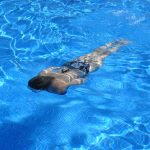Snorkeling is a popular recreational activity that allows you to observe underwater life and landscapes using a snorkel, mask, and fins. Since it takes place largely at the surface of the water, many wonder whether snorkelers need to have competent swimming skills. Here is an in-depth look at whether you need to know how to swim in order to enjoy snorkeling safely and comfortably.
Snorkeling Basics
Snorkeling involves using a few key pieces of gear:
Snorkel – A J-shaped tube that allows you to breathe while your face is underwater.
Mask – Covers your eyes and nose to improve underwater vision.
Fins – Flippers worn on your feet to aid propulsion and conserve energy while swimming.
The basic technique is to wear these items while floating on the surface of the water on your belly. By putting your face down into the water, you can use the snorkel to breathe and the mask to see the underwater sights. Fins help you efficiently swim and cover more area while snorkeling.

Weak Swimming Ability Can Complicate Snorkeling
While snorkeling does not require swimming laps or holding your breath underwater, a minimum level of comfort and swimming proficiency is recommended. Those who are completely unable to swim may find standard snorkeling challenging for these reasons:
Difficulty floating comfortably on the surface
Increased risk of falling face first into the water
Higher breathing and heart rates which consume more air
Limited ability to recover if fins are lost or mask leaks
Trouble managing equipment like defogging mask
Harder time reorienting body position from face down to face up
Less control swimming against currents or waves
Without basic comfort and competence swimming face down, floating, and surface swimming, many individuals may struggle to enjoy snorkeling or feel safe doing it.
Strong Swimmers Have a Clear Advantage
While complete non-swimmers may have difficulty, those will moderately strong swimming skills will likely find snorkeling much easier.
Snorkeling Proficiency Can Be Learned
The good news is you can learn and rapidly improve the necessary skills for recreational snorkeling through a bit of practice. Even weak or non-swimmers can quickly gain proficiency. Trying these steps in a shallow and confined area like a swimming pool is advisable:

Practice floating face down while wearing mask and snorkel
Focus on calm rhythmic breathing only through the snorkel
Work on clearing mask of water and equalizing mask seal
Swim laps on surface kicking with fins on for propulsion
Enter water and submerge face using proper technique and body position
After less than an hour of practicing these snorkeling basics, even very weak swimmers can adapt and gain comfort. Taking a beginner snorkeling lesson is another great way to rapidly pick up the basics. The small upfront time investment in learning technique pays big dividends in allowing you to snorkel safely.
Use a Flotation Device To Aid Non-Swimmers
For those unable to swim at all, using a flotation device like a simple waist belt, inflatable vest, or flotation wetsuit can enable enjoying snorkeling while keeping your head comfortably above water. But be sure to first practice use of the snorkel gear in the shallow end. Relying solely on a flotation device without snorkeling practice is risky.
Start in Shallow, Calm Areas
When first learning, choose locations with very shallow depths of just a few feet and smooth water. Lagoons, reef flats, and protected coves inside harbors offer ideal first snorkeling spots. Lakes and pools also work well. Starting in shallow, calm environments builds critical confidence.
Don’t Snorkel Alone
No matter your ability, never snorkel alone. An experienced buddy should always accompany new snorkelers in case any problems occur. Panic and overexertion are leading risks even for strong swimmers. Having a capable snorkeling buddy nearby greatly improves safety.
Check Local Snorkeling Conditions
Always research local conditions before choosing a snorkeling spot as a beginner. Understanding the water depth, typical currents, surf, boat traffic, and weather patterns is crucial. Select locations well-suited to your ability. Ask for recommendations from local snorkeling outfitters.
Summary
In summary, complete non-swimmers can find snorkeling challenging, but the activity is accessible with proper instruction in technique and by starting in beginner friendly conditions. No high level of swimming proficiency is required to enjoy snorkeling shallow, calm areas – just a basic comfort level floating and breathing through the snorkel. As swimming ability improves, more adventurous snorkeling locations become accessible. With smart preparation and gradual experience, snorkeling opens up beautiful underwater worlds safely to all.


